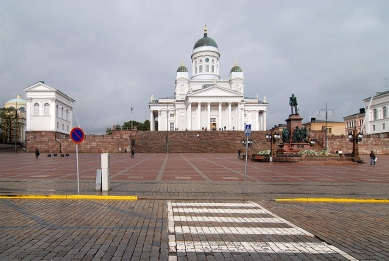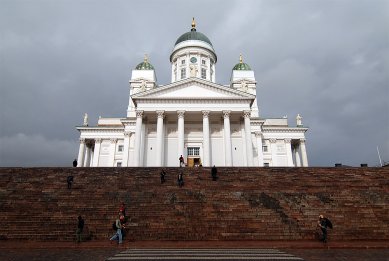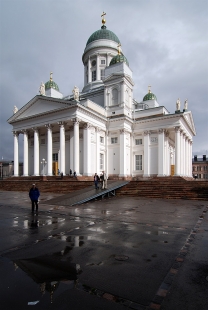
Dóm a Senátní náměstí

One of the monumental objects, built between 1818-22 by builder Carl Ludwig Engel as the dominant feature of Senate Square. Construction took place from 1831 to 1840. It stands on the basis of a Greek cross and is adorned with a magnificent facade featuring a Corinthian columned hall. Certain problems arose during the construction of the dome and the tower. Builder Ernst Bernhard Lohrmann, after Carl Ludwig Engel died, took over the completion and decided to construct a smaller dome and four corner towers.
In 1839, a magnificent terrace with corner pavilions, built by B. Lohrmann, was erected in front of the temple. The facade and side walls of the temple have sculptural decoration, which is the work of Berlin sculptor August Wredow and Hermann Schievelbein (1849). Inside the temple, we particularly point out the statues of the reformers Luther and Melanchthon by Hermann Schievelbein. The statue of the Finnish reformer Mikael Agricola also deserves attention.
Senate Square, lined with neoclassical government and university buildings designed by Prussian architect Carl Ludwig Engel, is truly one of the main features and symbols of Helsinki.
The buildings on the square, which some consider to be among the most beautiful in the world, were built between 1820 and 1850. In the summer, the square is the busiest place in the city. You will certainly feel that here beats the true heart of the city, enlivening the motionless majestic buildings surrounding it. The monument in the middle of the square, constantly adorned with flowers, commemorates Tsar Alexander II, who granted Finns many rights and freedoms and is still revered.
The cathedral is accessible from Monday to Saturday from 9 AM to 6 PM and on Sunday from 12 PM to 6 PM. Admission is free.
In 1839, a magnificent terrace with corner pavilions, built by B. Lohrmann, was erected in front of the temple. The facade and side walls of the temple have sculptural decoration, which is the work of Berlin sculptor August Wredow and Hermann Schievelbein (1849). Inside the temple, we particularly point out the statues of the reformers Luther and Melanchthon by Hermann Schievelbein. The statue of the Finnish reformer Mikael Agricola also deserves attention.
Senate Square, lined with neoclassical government and university buildings designed by Prussian architect Carl Ludwig Engel, is truly one of the main features and symbols of Helsinki.
The buildings on the square, which some consider to be among the most beautiful in the world, were built between 1820 and 1850. In the summer, the square is the busiest place in the city. You will certainly feel that here beats the true heart of the city, enlivening the motionless majestic buildings surrounding it. The monument in the middle of the square, constantly adorned with flowers, commemorates Tsar Alexander II, who granted Finns many rights and freedoms and is still revered.
The cathedral is accessible from Monday to Saturday from 9 AM to 6 PM and on Sunday from 12 PM to 6 PM. Admission is free.
The English translation is powered by AI tool. Switch to Czech to view the original text source.
0 comments
add comment















